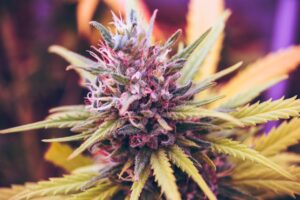Growing cannabis indoors requires care and proper equipment for healthier plants and a high yield. Among the many options available, the efficiency and reliability of HID cannabis grow lights make them some of the best in indoor cannabis cultivation. Here is a comprehensive explanation of HID grow lights and how to use them best in your indoor growing chamber.
Key Takeaways:
- HID grow lights ensure that the cannabis plants receive high-intensity illumination that is suitable for all growth stages, thus leading to healthier and faster-growing plants.
- The common HID light types include high-pressure sodium (HPS) and metal halide (MH), which are specifically designed for particular growth phases of cannabis cultivation.
- Proper use of HID lighting systems ensures robust plant development, higher yields, and efficient indoor cannabis cultivation.
What Are HID Grow Lights, and Why Are They Essential for Cannabis Cultivation?
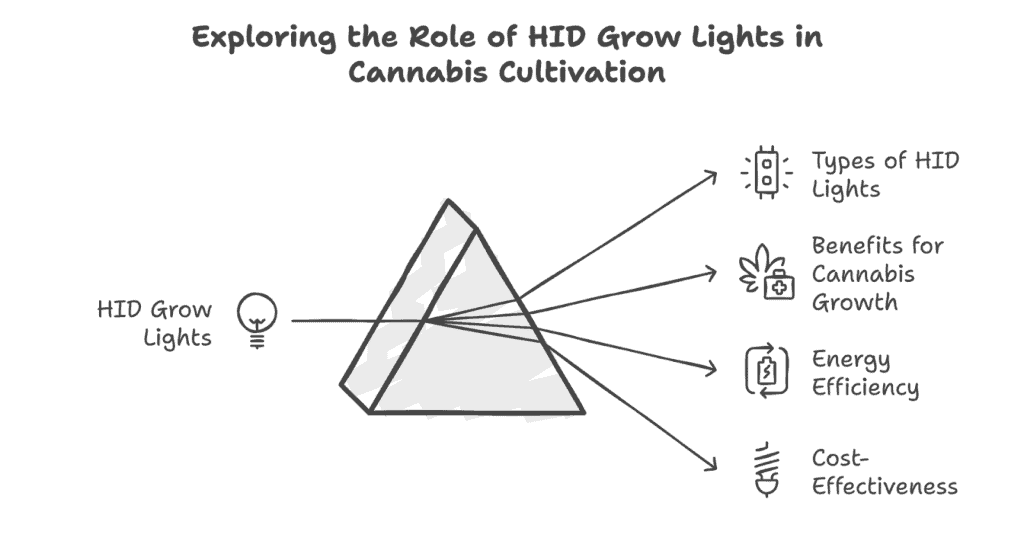
HID grow lights are high-intensity discharge lighting. They give very strong light spectra that closely resemble natural light. They are essential in cannabis growing since the emphasis is on giving the highest lumen output so that plants can grow vigorously from seedling to harvest. Since they produce very intense light, HID systems enable cannabis plants to attain the maximum photosynthesis, meaning stronger stems and larger leaves and denser buds.
Types of HID Grow Lights
HID lights come in several types with specific roles in the cannabis plant growth cycle:
Metal Halide (MH):
- This kind of light displays a bluish-white color, encouraging vegetative growth by stimulating healthy leaves and stems. This is necessary for robust development at the beginning stages.
- For growers who have vigorous foliage development and prepare their plants for intense flowering stages, this is a recommended light type.
High-Pressure Sodium (HPS):
- Produces a reddish-yellow light that promotes the flowering stage by promoting bud formation and resin production.
- Increases general yield and is often used in conjunction with MH lights for entire growth cycles.
Ceramic Metal Halide (CMH):
- Balanced spectrum of light, combining the best of both MH and HPS lights.
- Very useful for growers who want one lighting solution to cover all growth stages.
How Do HID Grow Lights Compare to Other Lighting Options?
When choosing a lighting solution for your grow room, it’s important to consider the benefits and trade-offs of HID grow lights versus other options like LED and fluorescent lights.
| Feature | HID Grow Lights | LED Grow Lights | Fluorescent Lights |
| Light Intensity | High | Moderate to High | Low |
| Energy Efficiency | Moderate | High | Moderate |
| Cost | Moderate to High | High | Low |
| Heat Output | High | Low | Low |
| Ideal Usage | All growth stages | All growth stages | Seedlings and small plants |
HID lights remain a preferred choice for many growers because of their intense light and cost-effectiveness for large-scale cultivation, though they require careful heat management.
How to Set Up HID Lighting in Your Grow Room?
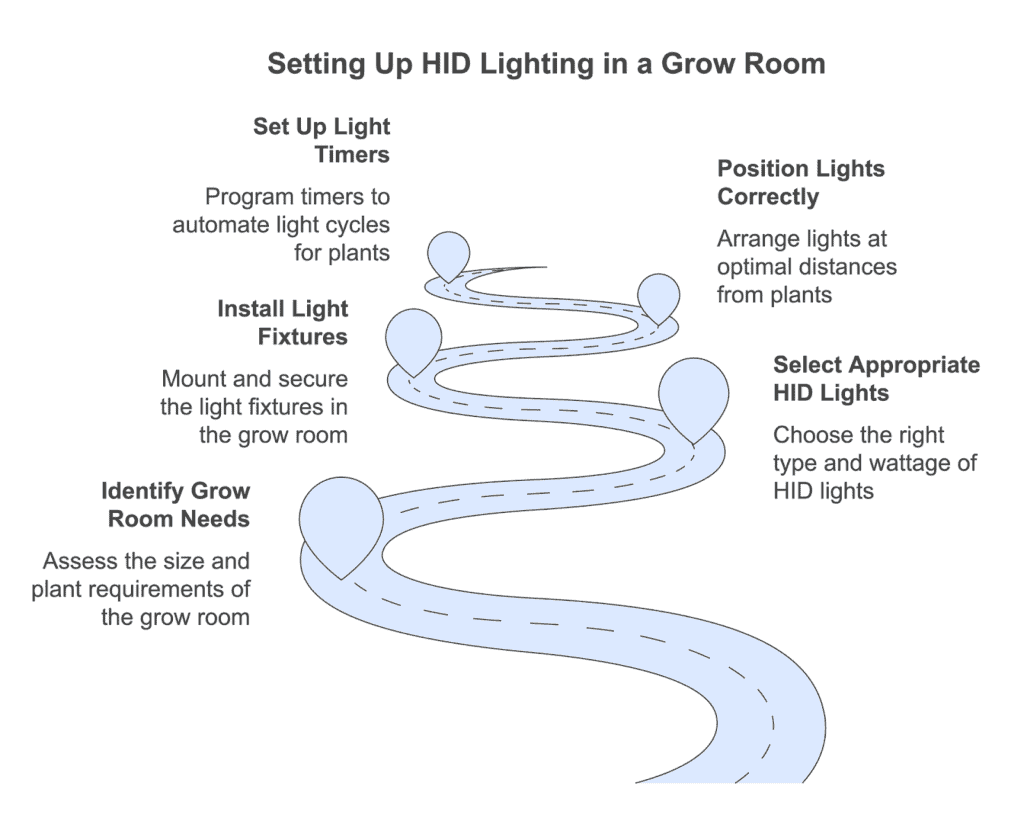
Setting up your HID grow light system correctly is critical for ensuring your cannabis plants receive optimal lighting. Proper setup can maximize yields and prevent issues such as light burn or uneven plant growth.
Selecting the Right Fixture and Bulb
- For larger grow rooms, use 1000-watt HID lights to light up more plants. In smaller rooms, use lower wattage according to the grow space.
- Select double-ended HID bulbs. Double-ended bulbs are much more efficient than single-ended bulbs and last much longer. Also, double-ended bulbs maintain a constant light intensity throughout their life.
- Invest in fixtures that are both HPS and MH compatible, so you can switch between the two for different growth phases.
Reflectors and Ballasts Installation
For a good HID system, its components should have reflectors and ballasts so that it works properly:
- Reflectors: Focus light directly on plants for even coverage and avoid waste while increasing the coverage.
- Ballasts: They control the power supply to your HID lamps, ensuring stable performance and preventing electrical surges that could damage the lights.
Heat and Ventilation Management
HID lights generate a lot of heat, so temperature management is very important:
- Use exhaust fans and intake systems to maintain airflow and prevent heat buildup.
- Pair your grow room with a hydroponic system, which helps regulate both humidity and temperature effectively.
- Utilize air-cooled reflectors in directing heat away from your grow area, thus having a more controlled environment.
What’s the Advantage of Using HID Grow Lights?
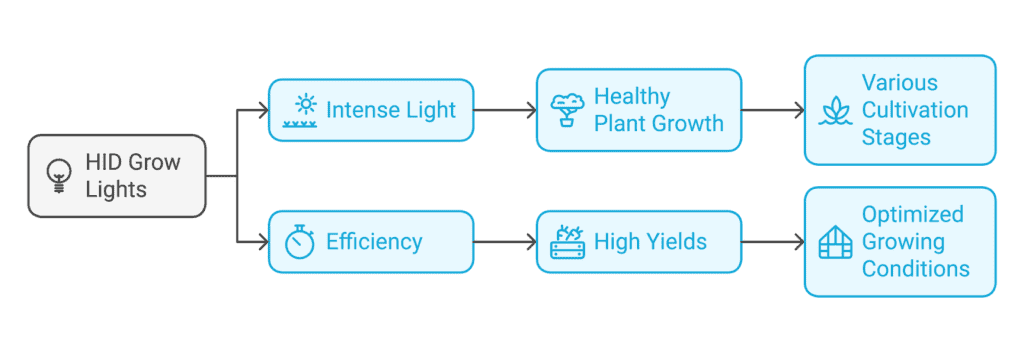
HID grow lights provide unmatched advantages to indoor cannabis growing. Let’s dive deeper into the benefits that make them the top choice for growers of cannabis.
Superior Spectrum for Cannabis Growth
- MH lights emit a strong blue light spectrum that mimics natural daylight, encouraging robust foliage development during the vegetative phase.
- HPS lights provide the red light spectrum, which is critical for flowering stages, enhancing bud density, and increasing resin production.
- Together, these lights offer a complete solution for all growth stages, ensuring healthier and more productive plants.
Cost-Effective for Large-Scale Cultivation
- Although HID systems draw much more energy, the entry costs appear relatively lower for today’s LED packages. This is what makes it more attractive for commercial growers.
- HID lights are engineered so that they give high lumens to ensure that the maximum light penetration and yield is achieved with every dollar spent.
Reliable and versatile for every growth stage
You can change the light spectrum of HID systems just by switching between HPS and MH bulbs. This adjustability makes sure that HID systems are always in tune with all phases of cannabis growth.
How to Maximize Yield Using HID Grow Lights?
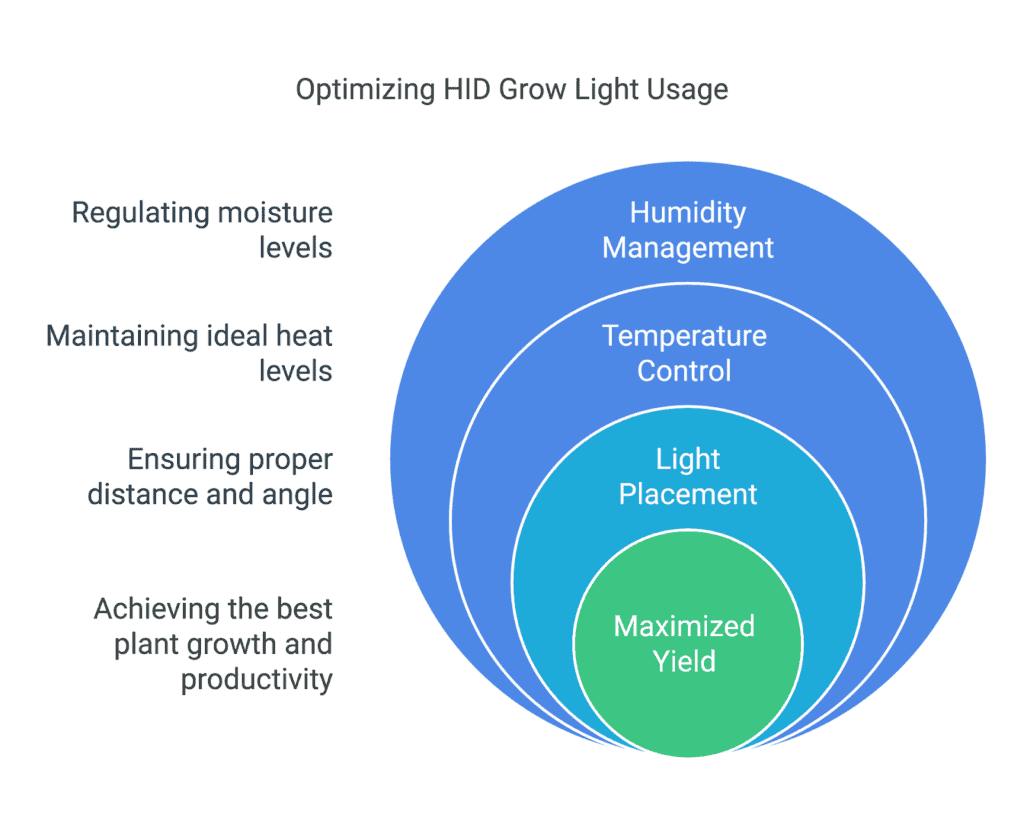
To get the best possible output for your grow room, you have to maximize your HID system for specific conditions. Let’s look at some strategies for maximizing yields:
Adjusting Light Spectrum and Intensity
- Use MH bulbs during the vegetative stage to promote strong leaf and root growth. These bulbs provide the blue spectrum necessary for photosynthesis.
- Switch to HPS bulbs when your plants reach the flowering stage, promoting bud formation and resin production.
- For larger grow rooms, use 1000-watt HID bulbs to ensure that the light intensity is adequate even at the edges of your plant canopy.
Proper Placement and Timing
- The distance between the light fixture and the canopy ought to be maintained at 18 to 24 inches so that there isn’t any damage occurring due to excess heat while allowing proper penetration of light.
- For vegetative growth, use the light cycle that is 18/6, while for the flowering cycles, keep the 12/12 light cycle as in the natural growth cycle.
Supplemental Light Sources
- Consider integrating the HID systems with LED grow lights or ceramic metal halide grow lights to close any spectrum gaps and minimize the energy consumption at large.
- Employ supplemental lighting with fluorescent grow lights for seedlings and early-stage clones.
Conclusion
HID grow lights are the backbone of growing cannabis indoors, providing extreme levels of light that plants require to grow perfectly. Understanding the various options of HID lights and making the most suitable selection according to the climate in your grow room will give you a chance to grow healthier, more potent, and productive cannabis plants. Investing in the right HID systems and maintaining them will always yield consistent success for growers at all levels of experience.
Frequently Asked Questions
What is the difference between MH and HPS bulbs?
MH bulbs emit a blue spectrum, ideal for vegetative growth, while HPS bulbs provide a red spectrum for flowering. Both use high-intensity discharge technology to enhance cannabis cultivation and work best with suitable light fixtures.
Can I use HID grow lights for all types of cannabis plants?
Yes, HID grow lights with high-intensity discharge technology suit all cannabis strains, from indica to hybrid. Their adaptability to different growth stages and compatibility with various light bulbs make them ideal for indoor cultivation.
How can I manage heat from HID lights in my grow room?
To handle heat from high intensity discharge lights, use exhaust fans and air-cooled reflectors to cool light bulbs. Adding LED light panels can help manage heat while ensuring optimal conditions for growing cannabis.








